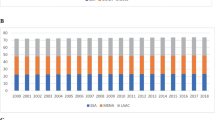Abstract
We study the interactions between information and communication technology (ICT) development and innovation in G-20 countries over 1961–2019. We establish whether there is temporal causality between these two variables. Employing the vector error correction modelling (VECM) framework, our findings render a grid of short-run and long-run causal relationships between ICT development and innovation, including long-run unidirectional causality from innovation to ICT development.
Similar content being viewed by others

Availability of data and material
Data will be made available upon request.
Notes
It is weighted-average of all these individual innovation indicators.
It is weighted-average of all these individual ICT development indicators.
0 and 1/2 indicate absence and one/two co-integrating vector(s) between ICT development and innovation, respectively.
With the indication of SLH/DFH/FBH/NEH, representing supply-leading/demand-following/feedback/neutrality hypotheses between ICT development and innovation.
With the symptom of SLH/DFH/FBH/NEH.
With the likes of SLH/DFH/FBH/NEH.
References
Adamides, E., & Karacapilidis, N. (2020). Information technology for supporting the development and maintenance of open innovation capabilities. Journal of Innovation and Knowledge, 5, 29–38.
Arvanitis, S., & Loukis, E. N. (2016). Investing the effects of ICT on innovation and performance of european hospitals: An exploratory study. European Journal of Health Economics, 17, 403–418.
Arvin, M. B., Pradhan, R. P., & Nair, M. (2021). Uncovering interlinks among ICT connectivity and penetration, trade openness, foreign direct investment, and economic growth: The case of the G-20 countries. Telematics and Informatics. https://doi.org/10.1016/j.tele.2021.101567 forthcoming.
Bartelsman, E. J., Falk, M., Hagsten, E., & Polder, M. (2019). Productivity, technological innovations and broadband connectivity: Firm-level evidence for ten European countries. Eurasian Economic Review, 9, 25–48.
Billon, M., Marco, R., & Lera-Lopez, F. (2017). Innovation and ICT use in the EU: An analysis of regional drivers. Empirical Economics, 53, 1083–1108.
Bresnahan, T. F., & Trajtenberg, M. (1995). General purpose technologies “engines of growth”?”. Journal of Econometrics, 65, 83–108.
Gogokhia, T., & Berulava, G. (2021). Business environment reforms, innovation and firm productivity in transition economies. Eurasian Economic Review, 11, 221–245.
Hawash, R., & Lang, G. (2020). Does the digital gap matter? Estimating the impact of ICT on productivity in developing countries. Eurasian Economic Review, 10, 189–209.
Majchrzak, A., & Malhotra, A. (2013). Towards an information systems perspective and research agenda on crowdsourcing for innovation. Journal of Strategic Information Systems, 22, 257–268.
Mokyr, J. (2010). The contribution of economic history to the study of innovation and technical change: 1750–1914. Handbook of the Economics of Innovation, 1, 11–50.
Nair, M., Pradhan, R. P., & Arvin, M. B. (2020). Endogenous dynamics between R&D, ICT and economic growth: Empirical evidence from the OECD countries. Technology in Society, 62, 101315. forthcoming.
O’Sullivan, D., & Dooley, L. (2009). Applying innovation. Sage Publications. https://doi.org/10.4135/9781452274898
Pradhan, R.P., Arvin, M.B., Nair, M., Bennett, S.E. and Bahmani, S. (2020a). Some determinants and mechanics of economic growth in middle-income countries: the role of ICT infrastructure development, taxation and other macroeconomic variables. Singapore Economic Review. https://doi.org/10.1142/S0217590820500563
Pradhan. R. P., Sarangi, A. K., Maity, C. and Behera, R. R. (2021). ICT infrastructure and economic growth in G-20 countries: new insights from ARDL modelling. Journal of Developing Areas. (forthcoming)
Pradhan, R. P., Arvin, M. B., Mital, J., & Bahmani, S. (2016). Relationships between telecommunications infrastructure, capital formation, and economic growth. International Journal of Technology Management, 70(2–3), 157–176.
Pradhan, R. P., Arvin, M. B., Nair, M., & Bennett, S. E. (2017). The innovation- growth link in OECD countries: Could other macroeconomic variables matter? Technology in Society, 51, 113–123.
Pradhan, R. P., Arvin, M. B., Nair, M., & Bennett, S. E. (2020a). Sustainable economic growth in the European union: the role of ICT, venture capital and innovation. Review of Financial Economics, 38(1), 34–62.
Pradhan, R. P., Arvin, M. B., Nair, M., Bennett, S. E., & Hall, J. H. (2018). The information revolution, innovation diffusion and economic growth: An examination of causal links in European countries. Quality & Quantity, 53(3), 1529–1563.
Pradhan, R. P., & Sahoo, P. (2020). Are there links between financial inclusion, mobile telephony, and economic growth? Evidence from Indian states. Applied Economics Letter, 28(4), 310–314.
Sarangi, A. K., & Pradhan, R. P. (2021). ICT infrastructure and economic growth: A critical assessment and some policy implications. Decision, 47(4), 363–383.
Schumpeter, J. A. (1934). The theory of economic development: An inquiry into profits, capital, credit, interest and the business cycle. Harvard University Press.
Acknowledgements
The authors are grateful to three anonymous reviewers and editor of this journal for helpful comments, which have improved the overall quality of this paper.
Funding
Authors did not receive any funding for this work.
Author information
Authors and Affiliations
Contributions
First author (RPP) has contributed to drafting, formulation, review of methods, illustrations, calculations, interpretation of data, conceptual layout of the paper, and editing. Second author (AKS) has done review of methods, conceptual layout of the paper, and editing. Third author (AS) has done review of methods, conceptual layout of the paper, and editing.
Corresponding author
Ethics declarations
Conflict of interest
Authors declare no conflict of interest for the present study.
Additional information
Publisher's Note
Springer Nature remains neutral with regard to jurisdictional claims in published maps and institutional affiliations.
Appendix A: Derivation of the composite indices of innovation activities and ICT development, using principal component analysis
Appendix A: Derivation of the composite indices of innovation activities and ICT development, using principal component analysis
The study forms two composite indices for innovation activities and ICT development, henceforth denoted by ‘CII’ and ‘CIC’. This is obtained through principal component analysis (PCA), by means of seven innovation indicators, namely, PAT, TAT, RDE, RDA, TRD, HTE, and STA, and five ICT development indicators, namely, TEL, MOB, INU, INS, and FIB, respectively. The detailed of these variables are listed and defined in the text (see Sect. 2). Three trees are used to have both CII and CIC: (1) organizing data in the identical order to generate an input matrix for the principal components; (2) engaging PCA, eigenvalues, factor loadings, and principal components are resulting; and (3) the principal components are recycled to construct CII and CIC for each country for every year. The comprehensive discussions of these steps to have these indices are available in papers such as Pradhan et al., (2020a, 2020b), and Nair et al. (2020). Tables A.1 and A.2 report the PCA results, while Figs. A.1 and A.2 present the variable loading plots for CII and CIC.
Variable loading plots for deriving CII. PAT is patents- both residents and non-residents, TAT is trademarks- both residents and non-residents, RDE is research and development (R&D) expenditure, RDA is researchers in R&D activities, TRD is technicians in R&D activities, HTE is high-technology export, STJ is scientific and technical journal articles
Rights and permissions
About this article
Cite this article
Pradhan, R.P., Sarangi, A.K. & Sabat, A. The effect of ICT development on innovation: evidence from G-20 countries. Eurasian Econ Rev 12, 361–371 (2022). https://doi.org/10.1007/s40822-021-00189-y
Received:
Revised:
Accepted:
Published:
Issue Date:
DOI: https://doi.org/10.1007/s40822-021-00189-y





